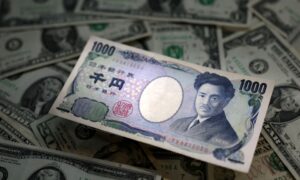Safe-Haven Yen Jumps as Credit Suisse Deal Sparks Further Jitters
Distressed Patriotic Flag Unisex T-Shirt - Celebrate Comfort and Country $11.29 USD Get it here>>


TOKYO/LONDON—Japan’s yen rallied on Monday as investors sought out safe assets after UBS’ cut-price takeover of its beleaguered rival Credit Suisse failed to quell market nerves.
Under the deal, holders of $17 billion of Credit Suisse additional tier-1 (AT1) bonds will be wiped out. That angered some of the holders of the debt who thought they would be better protected than shareholders and unnerved investors in other banks’ AT1 bonds.
The yen—long seen as a safe currency to hold at times of stress—rallied as a drop in Asian bank stocks overnight spread to Europe on Monday.
The dollar slid to its lowest since Feb. 10 at 130.55 yen, and was last down 0.75 percent at 130.83.
“The market’s driving force is risk aversion,” said Takahiro Sekido, chief Japan strategist at MUFG.
“I’m not so pessimistic, but still we have to wait and see how much we will see risk contagion from Europe,” he said.
Europe’s banking stocks index fell 3.12 percent in early trading.
Other currencies were little changed, with most of the action taking place in stock and bond markets.
The euro was down 0.11 percent against the dollar at $1.065, while the British pound was up 0.14 percent at $1.22.
The dollar rose 0.31 percent against the Swiss franc to 0.929.
As part of regulators’ efforts to shore up confidence in the global banking system, central banks moved on Sunday to bolster the flow of cash around the world.
The U.S. Federal Reserve offered daily currency swaps to ensure banks in Canada, Britain, Japan, Switzerland, and the eurozone would have the dollars needed to operate, echoing actions taken during the COVID-19 crisis of 2020.
US Bond Rally Weighs on Dollar
The sharp drop in U.S. bond yields made the dollar less attractive and lessened its appeal as a safe-haven asset, said Alvin Tan, head of Asia FX strategy at RBC Capital Markets.
The U.S. dollar index—which measures the currency against six major peers—was flat at 103.79, following last week’s 0.73 percent fall.
“As U.S. yields have fallen, and they continue to fall this morning, that’s dragged down the U.S. dollar,” he said. “The yen essentially is the cleanest safe-haven in FX.”
Yields on 10-year U.S. Treasury notes were down 8 basis points to 3.313 percent on Monday as investors moved into government bonds, which are seen as the safest assets, and bet the Federal Reserve would now struggle to raise interest rates much further.
U.S. 10-year yields, which move inversely to prices, stood at a 16-year high of 4.091 percent at the start of March.
The Fed’s latest rate decision is due on Wednesday and adds an additional layer of uncertainty.
Rates currently stand at 4.5 percent to 4.75 percent, and traders now think the Fed is likely to hold them there on Wednesday, according to derivative market pricing.
They are positioned for a peak in rates in May at around 4.7 percent, followed by a steady series of cuts into the end of the year.
Australia’s dollar was 0.21 percent lower at $0.669. The U.S. dollar slipped 0.09 percent against its Canadian counterpart to C$1.372.
In cryptocurrencies, bitcoin rose to a nine-month high of $28,519, last trading 0.91 percent higher at $28,311.
By Kevin Buckland and Harry Robertson




